
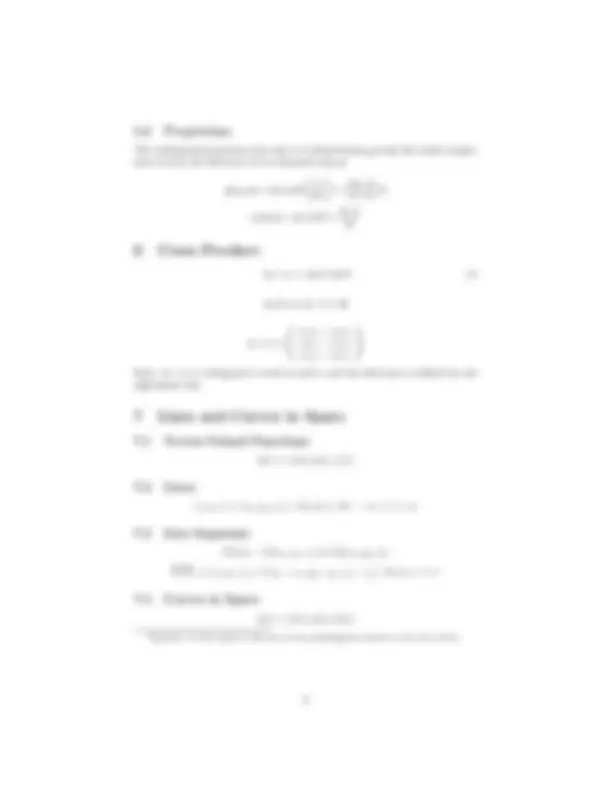
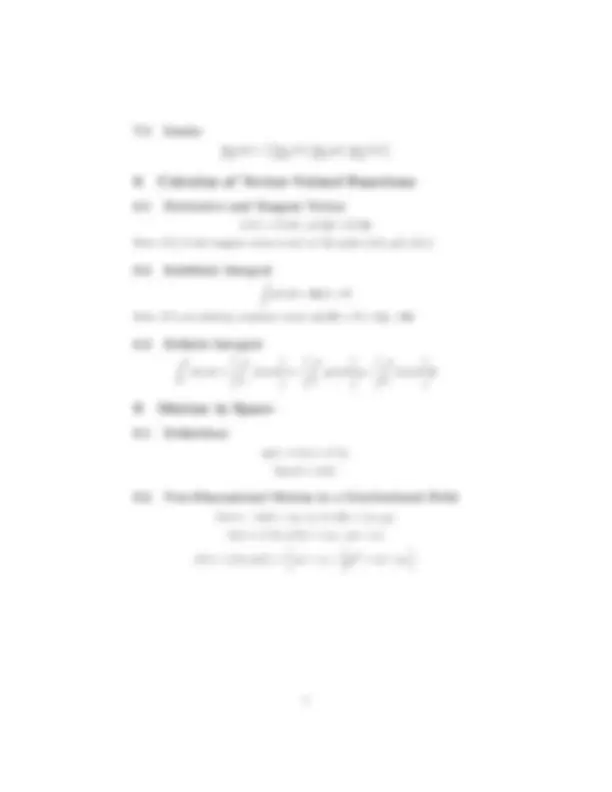
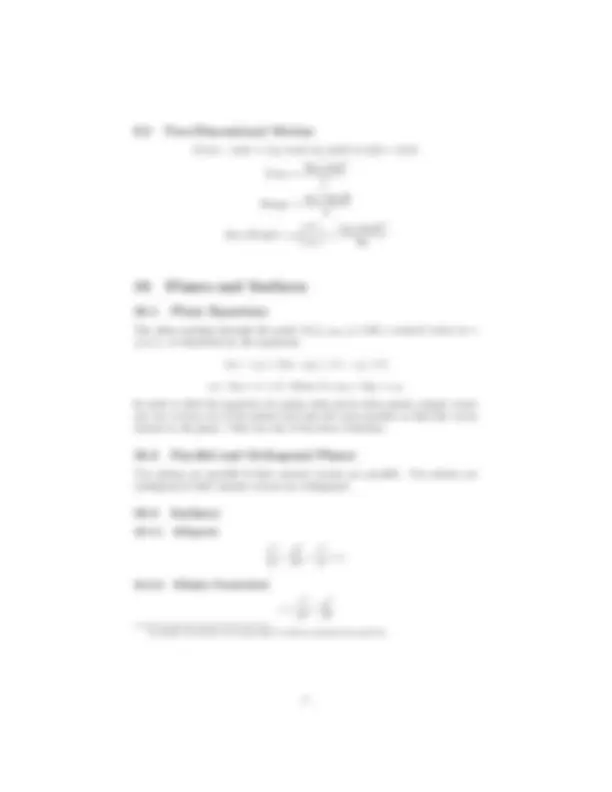
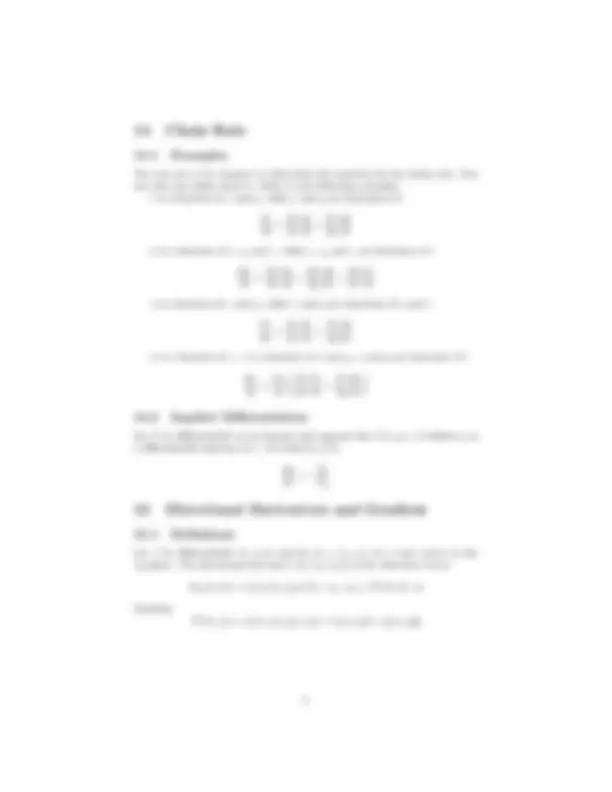
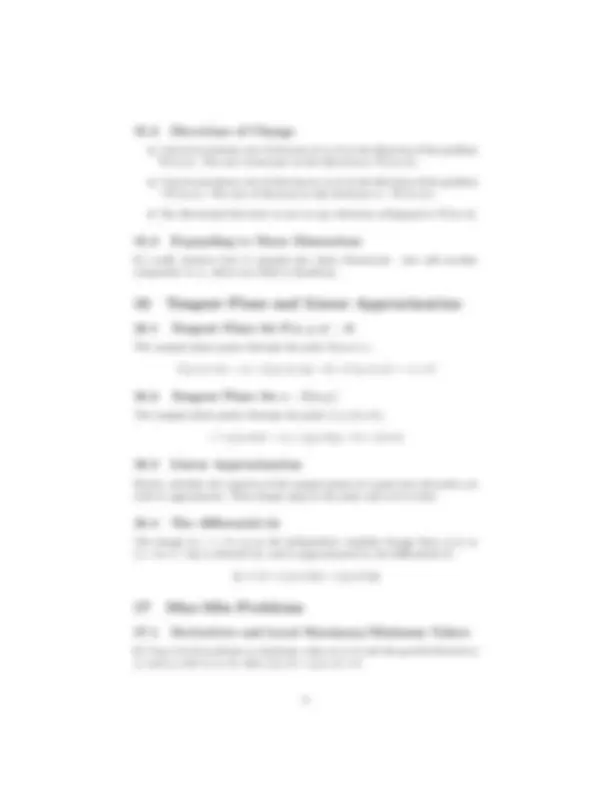
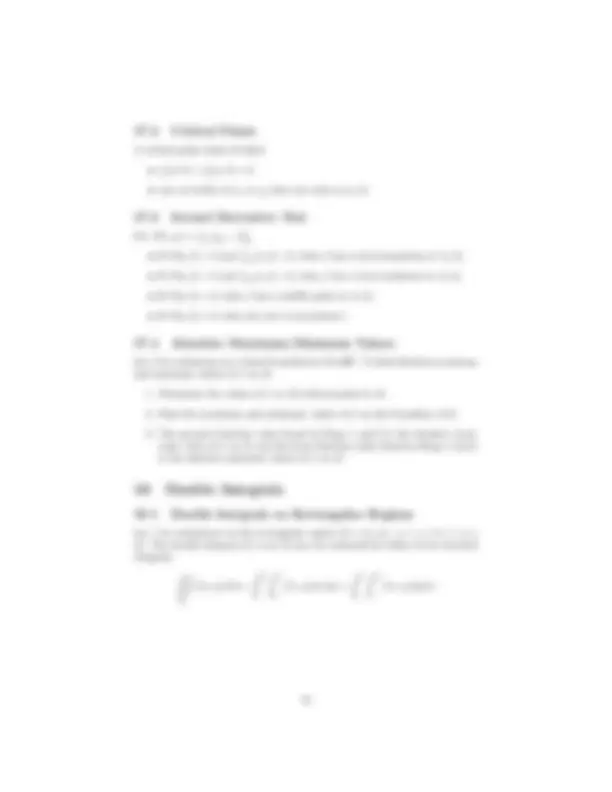
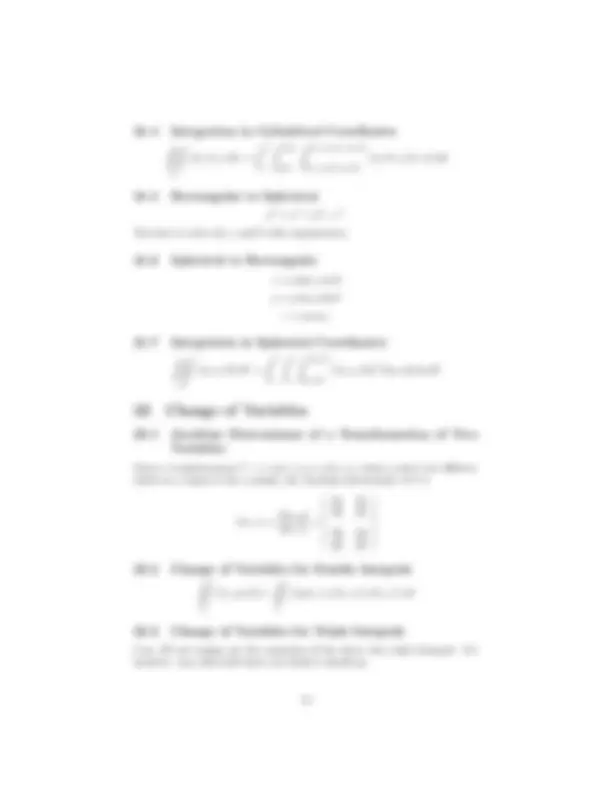
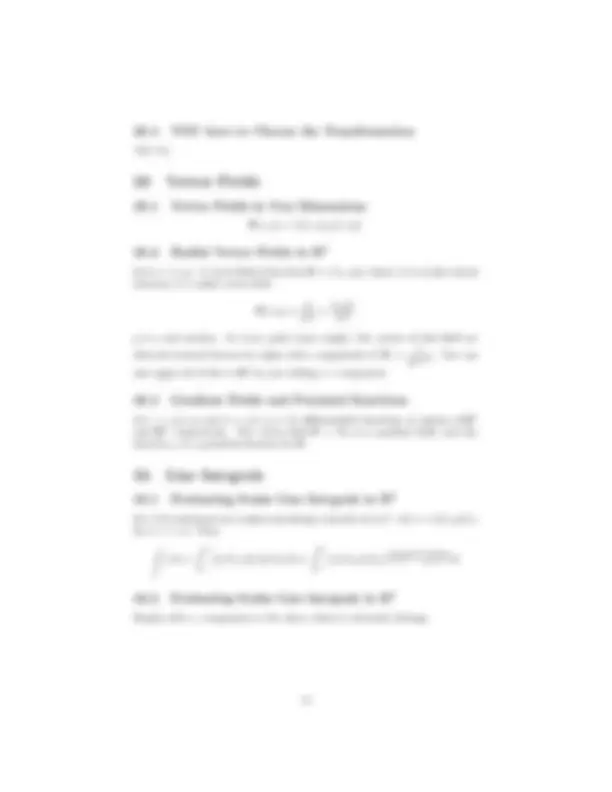
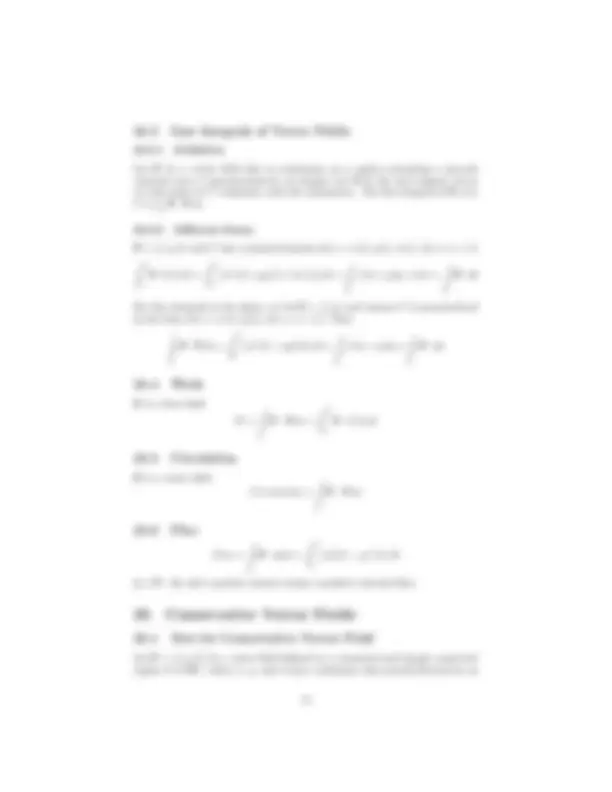
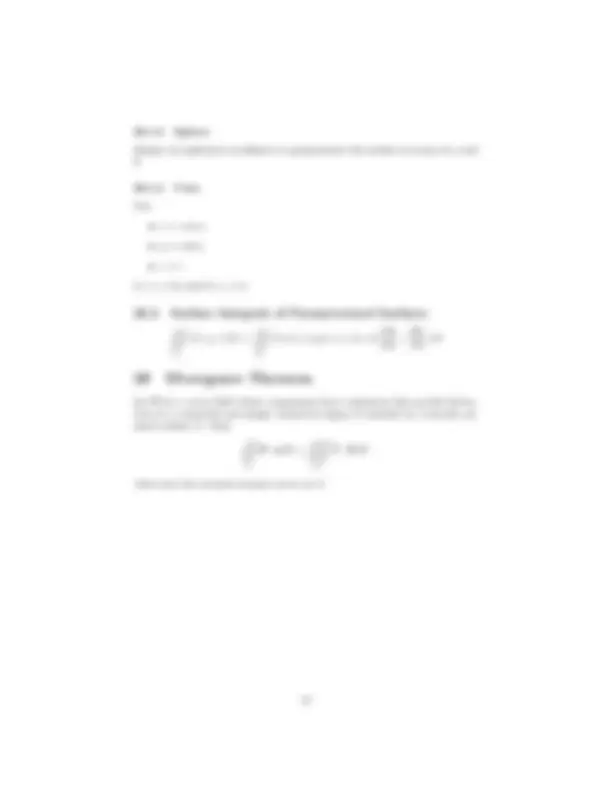


Study with the several resources on Docsity

Earn points by helping other students or get them with a premium plan


Prepare for your exams
Study with the several resources on Docsity

Earn points to download
Earn points by helping other students or get them with a premium plan
Community
Ask the community for help and clear up your study doubts
Discover the best universities in your country according to Docsity users
Free resources
Download our free guides on studying techniques, anxiety management strategies, and thesis advice from Docsity tutors
Calculus 3 Multivariable Calculus review and formula cheat sheet
Typology: Cheat Sheet
1 / 18

This page cannot be seen from the preview
Don't miss anything!











It is not guaranteed that I have every single bit of necessary information for the course. This happened to be some of what I needed to know this specific semester in my course. For example, Stokes’ Theorem is not even mentioned.
Given : P (x 1 , y 1 ) & Q(x 2 , y 2 )
x 2 − x 1 y 2 − y 1
let v =
v 1 v 2
& u =
u 1 u 2
cv =
cv 1 cv 2
|v| =
v 12 + v^22
v + u =
v 1 + u 1 v 2 + u 2
i =
& j =
v = v 1 i + v 2 j
cv |v|
∣ =^ |c|
cv |v| ‖ v
4 Vectors in Three Dimensions
Everything in the above section can be expanded to three dimensions. Simply add another component.
k =
xy-plane {(x, y, z) : z = 0} xz-plane {(x, y, z) : y = 0} yz-plane {(x, y, z) : x = 0}
Sphere: (x − a)^2 + (y − b)^2 + (z − c)^2 = r^2
5 Dot Product
u · v = u 1 v 1 + u 2 v 2 + u 3 v 3 = |u||v| cos θ u ⊥ v ⇔ u · v = 0 u ‖ v ⇔ u · v = ±|u||v|
lim t→a r(t) =
lim t→a f (t), lim t→a g(t), lim t→a h(t)
8 Calculus of Vector-Valued Functions
r′(t) = f ′(t)i + g′(t)j + h′(t)k
Note: r′(t) is the tangent vector to r(t) at the point (f (t), g(t), h(t)).
r(t) dt = R(t) + C
Note: C is an arbitrary constant vector and R = F i + Gj + Hk.
∫ (^) b
a
r(t) dt =
b
a
f (t) dt
i +
b
a
g(t) dt
j +
b
a
h(t) dt
k
9 Motion in Space
a(t) = v′(t) = r′′(t) Speed = |v(t)|
Given : v(0) = 〈u 0 , v 0 〉 & r(0) = 〈x 0 , y 0 〉 v(t) = 〈x′(t), y′(t)〉 = 〈u 0 , −gt + v 0 〉
r(t) = 〈x(t), y(t)〉 =
u 0 t + x 0 , −
gt^2 + v 0 t + y 0
Given : v(0) = 〈|v 0 | cos θ, |v 0 | sin θ〉 & r(0) = 〈 0 , 0 〉
T ime =
2 |v 0 | sin θ g
Range = |v 0 |^2 sin 2θ g
M ax Height = y
(|v 0 | sin θ)^2 2 g
10 Planes and Surfaces
The plane passing through the point P 0 (x 0 , y 0 , z 0 ) with a normal vector n = 〈a, b, c, 〉 is described by the equations:
a(x − x 0 ) + b(y − y 0 ) + c(z − z 0 ) = 0
ax + by + cz = d, where d = ax 0 + by 0 + cz 0
In order to find the equation of a plane when given three points, simply create any two vectors out of the points and take the cross product to find the vector normal to the plane. Then use one of the above formulae.
Two planes are parallel if their normal vectors are parallel. Two planes are orthogonal if their normal vectors are orthogonal.
10.3.1 Ellipsoid
x^2 a^2
y^2 b^2
z^2 c^2
10.3.2 Elliptic Paraboloid
z = x^2 a^2
y^2 b^2 It would be worth it to learn how to derive sections 9.2 and 9.3.
12 Limits and Continuity
The function f has the limit L as P (x, y) approaches P 0 (a, b).
lim (x,y)→(a,b)
f (x, y) = lim P →P 0
f (x, y) = L
If f (x, y) approaches two different values as (x, y) approaches (a, b) along two different paths in the domain of f , then the limit does not exist.
The function f if continuous at the point (a, b) provided:
lim (x,y)→(a,b)
f (x, y) = f (a, b)
13 Partial Derivatives
fx(a, b) = lim h→ 0
f (a + h, b) − f (a, b) h
fy (a, b) = lim h→ 0
f (a, b + h) − f (a, b) h
So basically just take the derivative of one (the subscript) given that the other one is a constant.
∂x
∂f ∂x
∂^2 f ∂x^2 = (fx)x = fxx
∂ ∂y
∂f ∂y
∂^2 f ∂y^2
= (fy )y = fyy
∂ ∂x
∂f ∂y
∂^2 f ∂x∂y
= (fy )x = fyx
∂ ∂y
∂f ∂x
∂^2 f ∂y∂x
= (fx)y = fxy
Note: fxy = fyx for nice functions.
Suppose the function f has partial derivatives fx and fy defined on an open region containing (a, b), with fx and fy continuous at (a, b). Then f is differen- tiable at (a, b). This also implies that it is continuous at (a, b).
14 Chain Rule
You can use a tree diagram to determine the equation for the chain rule. You can also just think about it. Refer to the following examples. z is a function of x and y, while x and y are functions of t
dz dt
∂z ∂x
dx dt
∂z ∂y
dy dt
w is a function of x, y, and z, while x, y, and z are functions of t
dw dt
∂w ∂x
dx dt
∂w ∂y
dy dt
∂w ∂z
dz dt
z is a function of x and y, while x and y are functions of s and t
∂z ∂s
∂z ∂x
∂x ∂s
∂z ∂y
∂y ∂s
w is a function of z, z is a function of x and y, x and y are functions of t
dw dt
dw dz
∂z ∂x
dx dt
∂z ∂y
dy dt
Let F be differentiable on its domain and suppose that F (x, y) = 0 defines y as a differentiable function of x. Provided Fy 6 = 0,
dy dx
Fx Fy
15 Directional Derivatives and Gradient
Let f be differentiable at (a, b) and let u = 〈u 1 , u 2 〉 be a unit vector in the xy-plane. The directional derivative of f at (a, b) in the direction of u is
Duf (a, b) = 〈fx(a, b), fy (a, b)〉 · 〈u 1 , u 2 〉 = ∇f (a, b) · u
Gradient ∇f (x, y) = 〈fx(x, y), fy (x, y)〉 = fx(x, y)i + fy (x, y)j
A critical point exists if either
Let D(x, y) = fxxfyy − f (^) xy^2
Let f be continuous on a closed bounded set R in R^2. To find absolute maximum and minimum values of f on R:
18 Double Integrals
Let f be continuous on the rectangular region R = {(x, y) : a ≤ x ≤ b, c ≤ y ≤ d}. The double integral of f over R may be evaluated by either of two iterated integrals:
∫ ∫
R
f (x, y) dA =
∫ (^) d
c
∫ (^) b
a
f (x, y) dx dy =
∫ (^) b
a
∫ (^) d
c
f (x, y) dy dx
Let R be a region bounded below and above by the graphs of the continuous functions y = g(x) and y = h(x), respectively, and by the lines x = a and x = b. If f is continuous on R, then
∫ ∫
R
f (x, y) dA =
∫ (^) b
a
∫ (^) h(x)
g(x)
f (x, y) dy dx
Let R be a region bounded on the left and right by the graphs of the continuous functions x = g(y) and x = h(y), respectively, and by the lines y = c and y = d. If f is continuous on R, then
∫ ∫
R
f (x, y) dA =
∫ (^) d
c
∫ (^) h(y)
g(y)
f (x, y) dx dy
area of R =
R
dA
19 Polar Double Integrals
Let f be continuous on the region in the xy-plane R = {(r, θ) : 0 ≤ a ≤ r ≤ b, α ≤ θ ≤ β}, where β − α ≤ 2 π. Then
∫ ∫
R
f (r, θ) dA =
∫ (^) β
α
∫ (^) b
a
f (r, θ) r dr dθ
Let f be continuous on the region in the xy-plane
R = {(r, θ) : 0 ≤ g(θ) ≤ r ≤ h(θ), α ≤ θ ≤ β}
where β − α ≤ 2 π. Then.
∫ ∫
R
f (r, θ) dA =
∫ (^) β
α
∫ (^) h(θ)
g(θ)
f (r, θ) r dr dθ
If f is nonnegative on R, the double integral gives the volume of the solid bounded by the surface z = f (r, θ) and R.
D
f (r, θ, z) dV =
∫ (^) β
α
∫ (^) h(θ)
g(θ)
∫ (^) H(r cos θ,r sin θ)
G(r cos θ,r sin θ)
f (r, θ, z) dz r dr dθ
ρ^2 = x^2 + y^2 + z^2
You have to solve for ϕ and θ with trigonometry.
x = ρ sin ϕ cos θ y = ρ sin ϕ sin θ z = ρ cos ϕ
D
f (ρ, ϕ, θ) dV =
∫ (^) β
α
∫ (^) b
a
∫ (^) h(ϕ,θ)
g(ϕ,θ)
f (ρ, ϕ, θ)ρ^2 sin ϕ dρ dϕ dθ
22 Change of Variables
Given a transformation T : x = g(u, v), y = h(u, v), where g and h are differen- tiable on a region of the uv-plane, the Jacobian determinant of T is
J(u, v) =
∂(x, y) ∂(u, v)
∂x ∂u
∂x ∂v
∂y ∂u
∂y ∂v
R
f (x, y) dA =
S
f (g(u, v), h(u, v))|J(u, v)| dA
I am SO not typing out the expansion of the above into triple integrals. It’s intuitive. Just add stuff where you think it should go.
Just cry.
23 Vector Fields
F(x, y) = 〈f (x, y), g(x, y)〉
Let r = (x, y). A vector field of the form F = f (x, y)r, where f is a scalar-valued function, is a radial vector field.
F(x, y) =
r |r|p^
〈x, y〉 |r|p
p is a real number. At every point (sans origin), the vectors of this field are
directed outward format he origin with a magnitude of |F| =
|r|p−^1
. You can
also apply all of this to R^3 by just adding a z component.
Let z = ϕ(x, y) and w = ϕ(x, y, z) be differentiable functions on regions of R^2 and R^3 , respectively. The vector field F = ∇ϕ is a gradient field, and the function ϕ is a potential function for F.
24 Line Integrals
Let f be continuous on a region containing a smooth curve C : r(t) = 〈x(t), y(t)〉, for a ≤ t ≤ b. Then
∫
C
f ds =
∫ (^) b
a
f (x(t), y(t))|r′(t)| dt =
∫ (^) b
a
f (x(t), y(t))
x′(t)^2 + y′(t)^2 dt
Simply add a z component to the above where it obviously belongs.
D. Then, F is a conservative vector field on D (there is a potential function ϕ such that F = ∇ϕ) if and only if
∂f ∂y
∂g ∂x
∂h ∂x
∂g ∂z
∂h ∂y
For vector fields in R^2 , we have the single condition ∂f ∂y
∂g ∂x
Suppose F = 〈f, g, h〉 is a conservative vector field. To find ϕ such that F = ∇ϕ, take the following steps:
Beginning the procedure with ϕy = g or ϕz = h may be easier in some cases. This method can also be used to check if a vector field is conservative by seeing if there is a potential function.
C
F · T ds =
C
F · dr = ϕ(B) − ϕ(A)
Let R in R^2 (or D in R^3 ) be an open region. Then F is a conservative vector field on R if and only if
C F^ ·^ dr^ = 0 on all simple closed smooth oriented curves C in R.
26 Green’s Theorem
C
F · dr =
C
f dx + g dy =
R
∂g ∂x
∂f ∂y
dA
C
x dy = −
C
y dx =
C
(x dy − y dx)
C
F · n ds =
C
f dy − g dx =
R
∂f ∂x
∂g ∂y
dA
27 Divergence and Curl
div(F) = ∇ · F = ∂f ∂x
∂g ∂y
∂h ∂z
div(F) = 3 − p |r|p
F =
r |r|p^
〈x, y, z〉 (x^2 + y^2 + z^2 )p/^2
curl(F) = ∇ × F
Just derive the curl by doing the cross product.
28 Surface Integrals
28.1.1 z is Explicitly Defined
Use x = x, y = y, and since z is explicitly defined, you already have what z equals.
28.1.2 Cylinder
Simply use cylindrical coordinates to parameterize the surface in terms of θ and z.